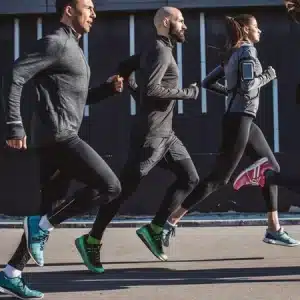Is there a right way to train endurance athlete or endurance training events? Coaches and exercise scientists have been researching this topic for years. Although the science and practical application has evolved over the years, there is no right way to train for the optimal peak performance of an endurance athlete. This article presents various endurance training techniques that have worked for several individuals in the past and we can apply these techniques to increase our athletic performance.
Base Training for an Endurance Athlete
How much mileage should endurance athletes accumulate before they embark on any form of quality training? This is a very good question and the answer we must ask is how much they have been running in the past and whether they have suffered any previous injuries. These answers will help embark on a systematic approach to increase the quality of volume of these individuals without injuring them. It is also wise to accomplish a movement screen to assess the quality of basic movements. The basic screen should be as follows:
- Single-Leg Squat
- Push-ups or Push-up on your knees
- 3-Way Lunge (Sagittal, Frontal, and Transverse Plane)
- Single-Leg Stiff-Legged Deadlift to Reach
- Active Straight-Legged Raise
- Shoulder Mobility
- Bird Dog Plank
By performing this screen, the coach and the athlete will know where the individual movement capabilities are. If one cannot perform well on this movement screen, then they are prohibited to increase their volume of running. The safe way to increase one’s mileage is by following the cycle below:
Week One Week Two Week Three Week Four Week Five Week Six
30 MPW 30 MPW 36 MPW 36 MPW 42 MPW 30 MPW
By increasing one’s volume by two percent every two weeks, one can slowly adapt to the training that is being presented to them. It is also wise to incorporate recovery weeks so that the individual can fully adapt to the training that is being presented to them.
Hill Training for an Endurance Athlete
Hill training was first used by two different coaches of the 1950s, Arthur Lydiard and Percy Cerutty. Arthur Lydiard was a track coach from New Zealand and used base-building techniques such as steady-state running in the fall/early winter and faster up-tempo running in the spring in order to peak for summer competitions. What most people did not realize was that he incorporated hilly fartlek runs and sprints not only to boost leg strength but also to increase leg turnover.
These techniques will obviously develop both power and leg speed for runners who training for the 800 meters through the 10k. For runners who are training for the marathon, these endurance training techniques will help condition the quadriceps muscles so that it would prevent them from getting DOMS (Delayed Onset Muscle Soreness).
Percy Cerutty used a similar concept except his training involved barefoot running and various forms of up-tempo training on the beaches of Australia. Cerutty felt that by building the intrinsic muscles of the feet, the athlete will be able to improve running economy and also proprioceptive awareness to as well.
Interval Training for an Endurance Athlete
Interval Training can be in many forms. We can perform interval training on the track, roads, or trails. We can also combine a small strength training session with an interval session to as well. This concept is very interesting because it helps reinforces our central nervous system to optimally improve the running economy, and strengthen tissues and ligaments as well.
The following is a sample session:
- Cleans: 3 sets of 5 reps
- Snatches: 3 sets of 5 reps
- Goblet Squat and progress onto a Single Leg Suitcase Squat: 3 sets of 5 reps
- Romanian Deadlift (RDL) and then progress onto a Single Leg RDL: 3 sets of 5 reps
- Lunge to Runner’s Pose: 3 sets of 5 reps
Then complete 5* 800 meters @ 5k race pace with a three-minute recovery in between. (Note: Exercises that are being described are very similar to the book that was published in Running Science, 2013).
Maximal Speed Development
Speed development is essential for all sports but it is also crucial in the endurance training events to as well. Speed development should be a year round process and should be incorporated in various segments throughout the course of any given training cycle. But how do we develop leg speed, fortunately they are a couple workouts that can be addressed in this segment. Here is an example:
- High Knee Jumps : 2 sets of 5 reps
- Split Squat Jumps: 2 sets of 5 reps
- Hip Drive/Alternate Hip Drive Drill (2*100 meters)
- Single Leg Vertical Hops: 2 sets of 5 reps
- Single Leg Hops (2*40 sec)
- High Knee Switches (2*100 meters)
- Sprinting On the Spot (2*30 sec)
Then complete a 1500m Breakdown:
400/400/300/200/200
Please take a 400 meter recovery jog in between the 400 meter intervals, 300 meter recovery jog in between the 300 meter interval, and a 200 meter recovery jog in between the 200 meter interval.
Or
Complete 8*200 meters faster than 800 meter race pace with a three minute recovery in between (Note: Exercises that are being described are very similar to the book that was published in Running Science 2013).
The following program is similar to the interval workout described earlier but instead of incorporating maximal power and strength, we are focusing on the rate of force production. This type of training is very crucial because it allows these individuals to move from one direction to another in a very rapid manner and this type of training is paramount for peak performance.

Nutrition and Recovery
This is the most important process of the program. Other than incorporating the methods described above into our routine, it is important to know what types of food an endurance athlete needs in order to fuel for peak performance?
A study conducted in 2004 by Mike Boit (Bronze medalist in the 800 meters in the 1972 Munich Olympics) noted that elite Kenyan distance runners would get a majority of their meals from carbohydrates (70 percent), proteins (10 percent), and healthy fats (13 percent). It is also noted that right after exercise, the Kenyan distance runners would consume carbohydrates and by practicing this method, these individuals are able to replenish their glycogen levels. The important thing to note is during their time at training camps, they were fed meals at least five times a day. These athletes were obviously training at least twice, sometimes three times a day during training camps but it was also noted that a majority of their meals came from organic sources. These nutritional methods that the Kenyan athletes have utilized allowed them to train at an optimal level and therefore produce high-level race performances.
In terms of recovery, the individuals that are training at a high level should focus on getting at least eight to ten hours of sleep each night. Since these individuals are expending high amounts of energy through their academic/professional/sporting careers, it is in their best interest to focus on having high-quality sleep. This will allow them to produce optimal peak performance in their competitions.
Injury Prevention
It is important to focus on prehab during your endurance training schedule. Gray Cook, who happens to be a physical therapist and the founder of the Functional Movement Systems (FMS), states that during high levels of repetitive abuse that we put our bodies through on a daily basis, we lose our quality of movement. An example is given below:
Ankle: Mobility
Knee: Stability
Hip: Mobility
Thoracic Region: Mobility
Scapula: Stability
Glenohumeral: Mobility
(Note: Concept was taken from Advances in Functional Training: Training Techniques for Coaches, Personal Trainers, and Athletes 2010)
It is important that these individuals work on mobility, stability, and proprioceptive awareness. The example is listed below:
- Single Leg Balance: with eyes open/closed, airex pad, and dyna disc
- Clamshells progress onto Side Plank with Hip Abduction
- Plank progress onto Plank to Push-Up
- Knee to Bridge
- Single Leg Bridge with Hip Abduction
- Single-Leg Heel Drops (five-second eccentric drop followed by a five-second concentric drop).
It is also noted to change one’s running footwear every three to five hundred miles worth of use. It is best for these individuals to purchase at least three pairs of footwear (one for training, one for speed work, and one for competition) so this way can preserve the life of these shoes and prevent injury at the same time. It is also recommended to go into a running specialty store to have one’s gait properly analyzed so that way one can purchase the right pair of shoes for their needs.
In conclusion, these methods and techniques listed in this article are suggestions that endurance athletes can follow to increase their performance in endurance training events. It is also noted that one should seek the help of a registered dietitian, strength coach, physical therapist, etc. to find out what program should be optimal for the individual not only to increase their athletic performance but to prevent injury as well.
Subscribe to www.healthieyoo.com for more tips for an endurance athlete to increase their athletic performance.
References –
- Anderson, Owen Running Science 2013
- Boyle, Michael Advances in Functional Training: Training Techniques for Coaches, Personal Trainers and Athletes 2010





